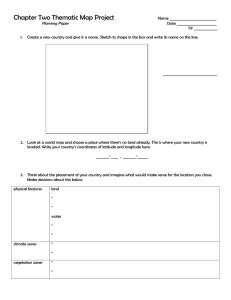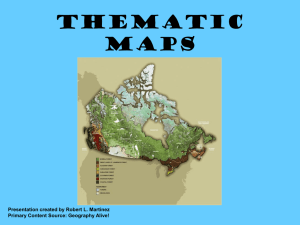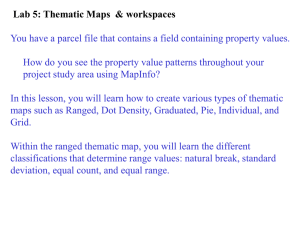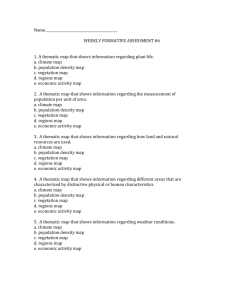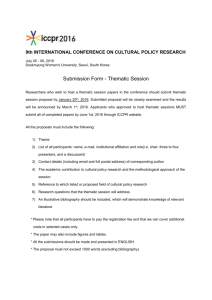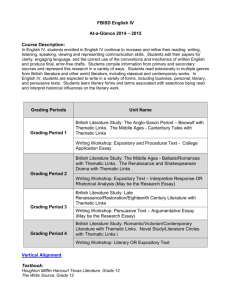DR. M. RAGHUNATHAN AWARD FOR BEST POSTER IN SPEECH
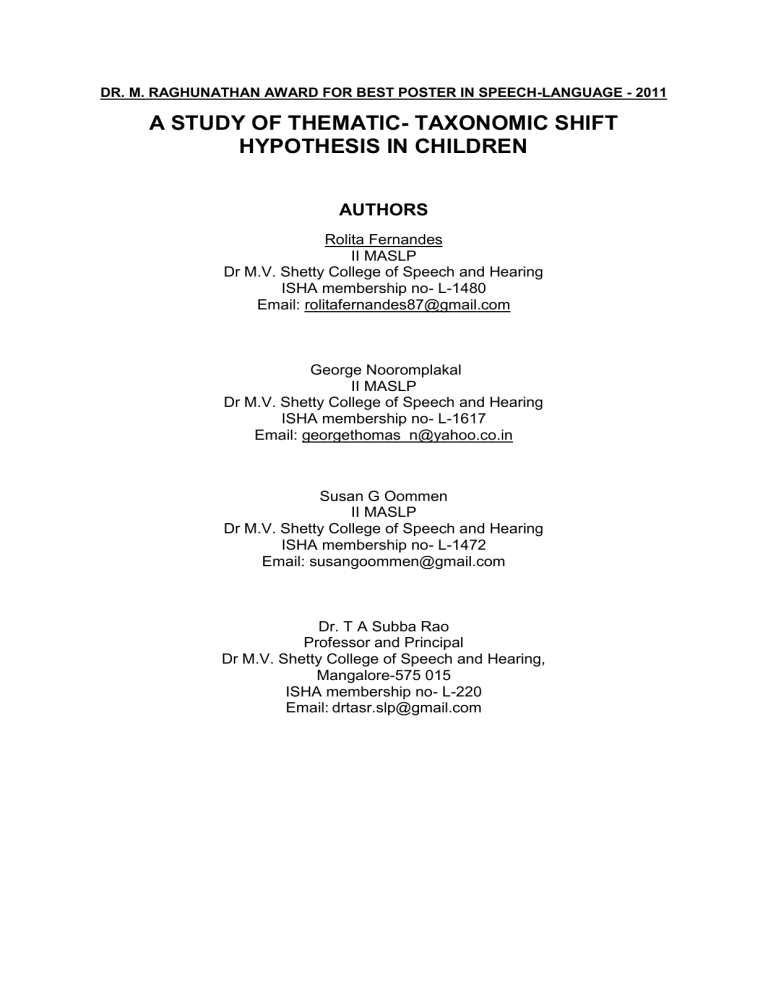
DR. M. RAGHUNATHAN AWARD FOR BEST POSTER IN SPEECH-LANGUAGE - 2011
A STUDY OF THEMATIC- TAXONOMIC SHIFT
HYPOTHESIS IN CHILDREN
AUTHORS
Rolita Fernandes
II MASLP
Dr M.V. Shetty College of Speech and Hearing
ISHA membership no- L-1480
Email: rolitafernandes87@gmail.com
George Nooromplakal
II MASLP
Dr M.V. Shetty College of Speech and Hearing
ISHA membership no- L-1617
Email: georgethomas_n@yahoo.co.in
Susan G Oommen
II MASLP
Dr M.V. Shetty College of Speech and Hearing
ISHA membership no- L-1472
Email: susangoommen@gmail.com
Dr. T A Subba Rao
Professor and Principal
Dr M.V. Shetty College of Speech and Hearing,
Mangalore-575 015
ISHA membership no- L-220
Email: drtasr.slp@gmail.com
A STUDY OF THEMATIC- TAXONOMIC SHIFT
HYPOTHESIS IN CHILDREN
ABSTRACT
INTRODUCTION
Cognitive development involves the transition from thematic knowledge, to a more abstract knowledge based on the taxonomic relations responsible for the way objects and events are grouped into categories. Thus during development children undergo a thematic - to - taxonomic shift that is responsible for mastering their dealings with the environment. Taxonomies are categories of objects that share a common essence. These may be natural kinds (e.g., pine tree and oak) or artifacts
(e.g., pencil and crayon). Thematic categories are bound by an event schema.
These include spatial (e.g., paper and desk), causal (e.g., student and pencil), and functional (e.g., pencil and paper).
Literature has shown that preschoolers sort objects into categories according to thematic relations. Mccauley & Sperber, (1976) studied semantic priming in 6 and
8year old and found that thematic priming was demonstrated in both groups, whereas taxonomic priming was demonstrated only by 8-year-olds. Preschoolers also demonstrate preferences for thematic relations during forced choice matching tasks and naming tasks. However, by 8 years of age and into adulthood, taxonomic relations are preferred in such tasks, leading to the hypothesis that conceptual development is characterized by a thematic to taxonomic shift (Murphy, 2001, 2003).
Several weaker versions of the shift hypothesis have been put forward. In forcedchoice matching tasks preschoolers tend to choose taxonomic relations rather than thematic relations (Waxman & Gelman, 1986). The kind of task given to children biases their preference for thematic or taxonomic relations (Waxman & Kosowsky,
1990; Waxman & Namy, 1997) and that thematic relations still play a role in both older children's and adult ’s conceptual organization (Markman, 1989; Sell, 1992).
Borghi, 2001 showed that there is no evidence of a shift from taxonomic - to - thematic knowledge organization using a production task.
NEED FOR THE STUDY
The literature confirms that there are several studies done on conceptual organisation in western countries. There has been an increased interest among
Indian researchers to study cognitive organisation across categories of objects, however studies involving objectives to differentiate thematic and taxonomical concepts in Indian context are not available. Hence, the present study focuses on conceptual organisation in typically developing 6 and 8 year old children based on the evidence from semantic priming of picture naming task.
AIM OF THE STUDY
The study aims at testing the thematic to taxonomial shift in typically developing 6 and 8 year old children.
METHODOLOGY
60 participants were assigned to various age and priming groups. The primed group and unprimed group both consisted each of 10 children (6 year old), 10 children (8 year old) and 10 adults (18-25 year old). They were ruled out for any visual, hearing, speech and language problem. All the participants were bilingual
Kannada –English speakers.
Black and white pictures of 32 concrete objects were chosen for primed experiment.
All objects were likely to be familiar to 6-year-olds. The taxonomic and thematic condition consisted of 8 pairs each of pictured objects.10 adults rated the strength within the pairs for the thematic relation on a scale from 1 (highly associated) to 3
(not associated) and from 1(very related) to 3(very unrelated) for taxonomic pairs.
The unprimed condition consisted of 16 target pictures. Participants in the primed group had to name the target pictures following primes that were related taxonomically, thematically, to the target object. Their reaction times (RTs) were compared with those of participants in the unprimed group who named the same target objects but without benefit of primes. Participants were told that objects would be presented on the screen, and they had to name the gray-bordered pictures (for the primed group) or all pictures for unprimed. The DMDX software controlled the presentation of the target picture as well as prime, and recorded the speech reaction.
The reaction time was measured for the target pictures and compared for analysis of shift hypothesis.
RESULT
Paired sample t test was done to analyze the results between primed and unprimed variables across three age groups as well as primed variables in each group. For 6 years old children mean reaction time for primed thematic variable was
887.0750 msec and for primed taxonomical variable was 950.1375msec. The reaction time of unprimed thematic variable was 877.6875 msec and for unprimed taxonomial variable was 869.2875msec. The paired sample comparison across primed and unprimed thematic and taxonomial variable was not significantly different with p>0.001. But the results are significantly different for primed thematic and taxonomial values with p<0.05.Therefore it indicates that 6 year old show better thematic relations.
For 8 year old children mean reaction time for primed thematic variable was
900.00 msec and for primed taxonomical variable was 875.1750 msec. The reaction time of unprimed thematic variable was 790.7750 msec and for unprimed taxonomial variable was 741.525 msec. The paired sample comparison across primed and unprimed thematic and taxonomial variable was not significantly different with p>0.001. But the results are significantly different for primed thematic and taxonomial values with p<0.05.therefore 8 year old have better taxonomial relations.
For adults mean reaction time of primed thematic variable was 876.9250 msec and for primed taxonomial variable was 914.8125 msec. The reaction time of unprimed thematic variable was 735.262 msec and for unprimed taxonomial variable was 756.1250 msec. The paired sample comparison across primed and unprimed thematic and taxonomial variable was not significantly different with p>0.001. But the results are significantly different for primed thematic and taxonomial values with p<0.05.
DISCUSSION
Overall in the present study, 6 year old had a better performance for thematic condition than for taxonomial condition. Whereas, 8 years old in primed conditions showed better taxonomial performance. Therefore the present study indicates a thematic to taxonomial shift in 6 and 8 year old children. The previous studies support the present study. For example, Inhelder and Piaget (1964) observed preschoolers sorting objects into categories according to spatial (thematic) relations rather than perceptual (taxonomic) similarity. Preschoolers also demonstrate preferences for thematic relations during forced choice matching tasks (Smiley &
Brown, 1979) and a variety of recognition and naming tasks (Lonardo & Bukatko,
1979). Mccauley & Sperber, (1976) studied semantic priming in 6 and 8year old and found that thematic priming was demonstrated in both groups, whereas taxonomic priming was demonstrated only by 8-year-olds.
Similarly, Murphy(2001, 2003) has speculated that by 8 years of age and into adulthood taxonomic relations are preferred. Where as in the present study adults have shown faster performance for thematic relations than for taxonomial relations and such poor support to shift hypothesis has also been reported by Markman, 1989;
Sell, 1992; Borghi, 2001. Hence the present study shows the thematic to taxonomial shift in 6 and 8 year old children and a reverse trend for adults.
CONCLUSION
The present study indicates that there is a transition from thematic knowledge, to a more abstract knowledge based on the taxonomic relations in 6 and 8 year old children. Thus during development children undergo a thematic - to - taxonomic shift.
But adults showed better thematic relations rather than taxonomial relations. The future studies can accommodate different levels of material for testing children and adults.
